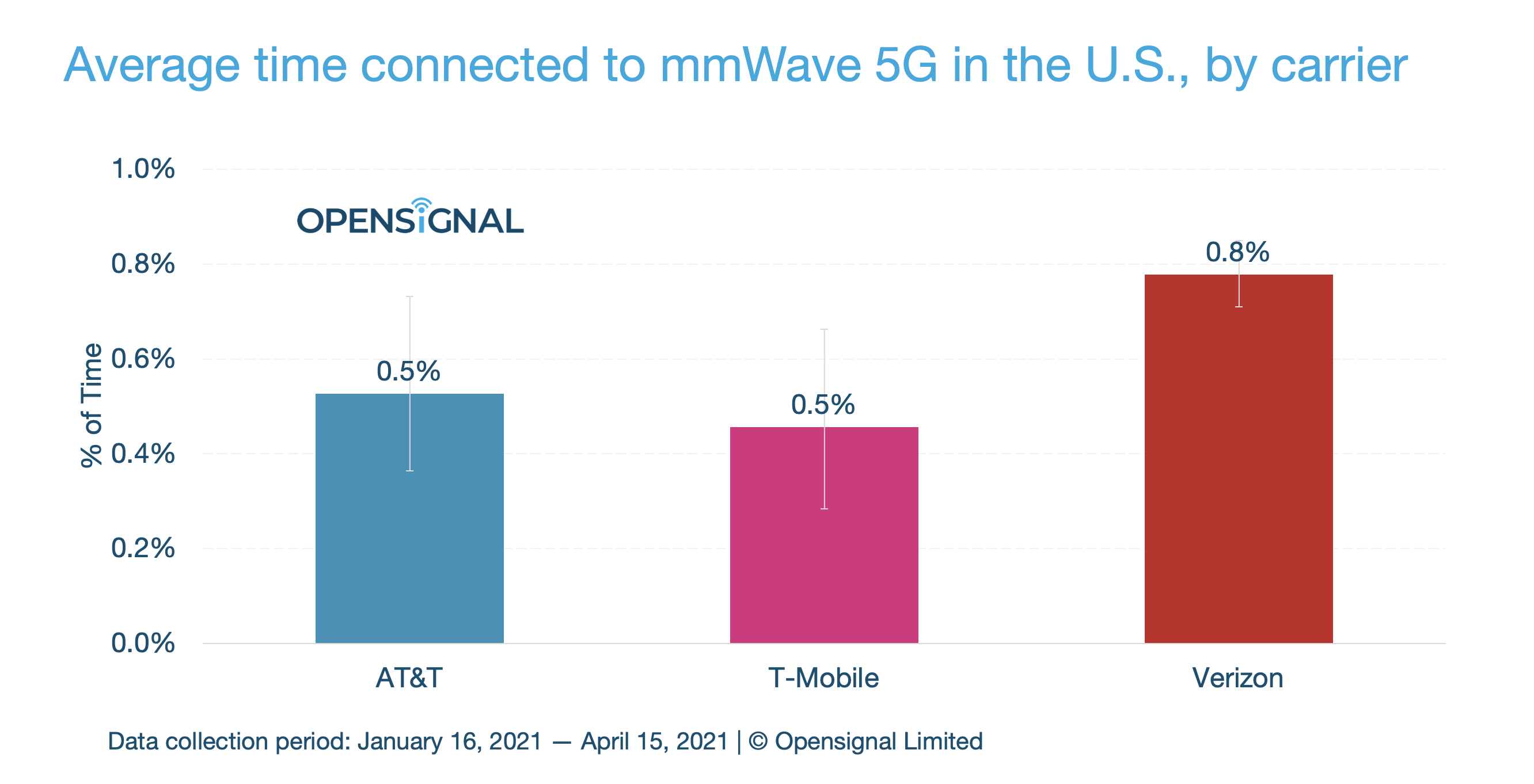In the past two years since the first commercial U.S. 5G mobile launch in April 2019, we have observed how 5G comes in several different flavors, depending on the type of frequency bands an operator uses: low-band, mid-band, millimeter-wave (mmWave) high-band 5G.
Opensignal has just published our latest USA 5G User Experience Report that analyzes the overall 5G mobile experience across all 5G frequency bands.
Here, we are publishing a complementary analysis looking specifically at mmWave 5G, a subset of 5G experience which is significantly different to other types of 5G services. The average 5G speeds are much faster because there is considerably more wireless capacity available on mmWave. And, mmWave 5G has very limited reach, which means mmWave reach is more similar to public Wifi than other cellular network technologies.
The three U.S. carriers use different names for the 5G services that utilize mmWave technology: AT&T’s mmWave 5G is named 5G Plus (5G+), Verizon launched 5G Ultra Wideband (5G UWB) using mmWave, while T-Mobile uses Ultra Capacity 5G as the name for the combined service using both its mid-band and mmWave networks, but in this analysis we have focused solely on the mmWave 5G component of T-Mobile’s Ultra Capacity 5G.

To date, in Opensignal’s global testing, the fastest average download speeds we have observed on any operator’s 5G service have been on Verizon’s mmWave 5G. In this analysis we have seen the fastest average mmWave 5G download speed of 692.9 Mbps using Verizon, which was three times as fast as our tests for AT&T and T-Mobile. We observed statistically tied average download speeds on AT&T and T-Mobile’s mmWave 5G services — 232.7 Mbps and 215.3 Mbps, respectively.
Verizon’s lead here is not surprising, given that Verizon’s 5G deployment strategy has placed a strong emphasis on mmWave while T-Mobile has focused on its 600 MHz and its 2.5 GHz spectrum assets for 5G services, and AT&T has mainly used low-band for 5G so far. Verizon holds significant quantities of mmWave spectrum and is estimated to have more than other U.S. carriers. In fact, Verizon launched its 5G service on mmWave 5G in April 2019 and only added its “Nationwide 5G” service later in October 2020 using Dynamic Spectrum Sharing (DSS) technology, which allows 5G to run simultaneously on the same spectrum band as 4G.
AT&T was the last among the three carriers to make its mmWave 5G service available to all its consumers in March 2020, after limiting it to its business customers since the launch in December 2018. On the other hand, T-Mobile quickly moved its focus to deploy 5G on its low-band and mid-band frequencies after its initial 5G network launch on mmWave back in June 2019.

In Opensignal’s analytics, we consistently see our Verizon mmWave 5G users experiencing a higher average time connected to mmWave 5G than users on the other U.S. carriers. In this 90 day period, our Verizon users saw a mean time connected to mmWave 5G of 0.8% compared with 0.5% on AT&T and T-Mobile. However, despite Verizon appearing to be ahead this result actually represents a statistical tie because of overlapping confidence intervals with AT&T.
Despite this low score, Verizon users have seen their time connected to mmWave 5G increase over the past year. When we first published a national time on mmWave 5G result for Verizon — in our USA, 5G User Experience Report - June 2020 — Verizon scored 0.4% but now it has reached almost double that mark at 0.8%(1). While T-Mobile’s and AT&T’s scores here of 0.5% are lower, they are comparable with Verizon’s recent past. On all three carriers there remains plenty of scope to increase the availability of mmWave 5G services.
Opensignal’s data shows that Verizon still holds a significant edge in the download speeds we recorded on mmWave 5G compared to its competitors. However, despite seeing some extremely fast download and upload speeds across the mmWave 5G networks in the U.S., our data shows that it is still rare for users to experience the blisteringly fast mmWave 5G speeds.
Endnote
(1) In June 2020, mmWave 5G was the only type of 5G offered by Verizon and so the overall 5G results in our report reflected Verizon’s mmWave 5G service. Since then, Verizon launched its nationwide 5G service using other spectrum bands and so this is no longer the case in our most recent U.S. 5G User report.
Opensignal Limited retains ownership of this insight including all intellectual property rights, data, content, graphs & analysis. Reports and insights produced by Opensignal Limited may not be quoted, reproduced, distributed, published for any commercial purpose (including use in advertisements or other promotional content) without prior written consent. Journalists are encouraged to quote information included in Opensignal reports and insights provided they include clear source attribution. For more information, contact [email protected].
